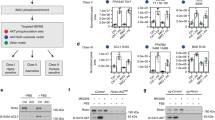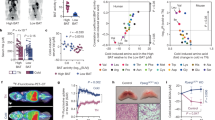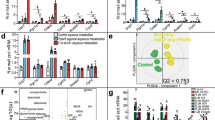Abstract
Adipose tissue plays important roles in regulating carbohydrate and lipid homeostasis, but less is known about the regulation of amino acid metabolism in adipocytes. Here we applied isotope tracing to pre-adipocytes and differentiated adipocytes to quantify the contributions of different substrates to tricarboxylic acid (TCA) metabolism and lipogenesis. In contrast to proliferating cells, which use glucose and glutamine for acetyl–coenzyme A (AcCoA) generation, differentiated adipocytes showed increased branched-chain amino acid (BCAA) catabolic flux such that leucine and isoleucine from medium and/or from protein catabolism accounted for as much as 30% of lipogenic AcCoA pools. Medium cobalamin deficiency caused methylmalonic acid accumulation and odd-chain fatty acid synthesis. Vitamin B12 supplementation reduced these metabolites and altered the balance of substrates entering mitochondria. Finally, inhibition of BCAA catabolism compromised adipogenesis. These results quantitatively highlight the contribution of BCAAs to adipocyte metabolism and suggest that BCAA catabolism has a functional role in adipocyte differentiation.
This is a preview of subscription content, access via your institution
Access options
Subscribe to this journal
Receive 12 print issues and online access
$259.00 per year
only $21.58 per issue
Buy this article
- Purchase on Springer Link
- Instant access to full article PDF
Prices may be subject to local taxes which are calculated during checkout






Similar content being viewed by others
References
Rosen, E.D. & Spiegelman, B.M. What we talk about when we talk about fat. Cell 156, 20–44 (2014).
Steppan, C.M. et al. The hormone resistin links obesity to diabetes. Nature 409, 307–312 (2001).
Glass, C.K. & Olefsky, J.M. Inflammation and lipid signaling in the etiology of insulin resistance. Cell Metab. 15, 635–645 (2012).
Turer, A.T. & Scherer, P.E. Adiponectin: mechanistic insights and clinical implications. Diabetologia 55, 2319–2326 (2012).
Herman, M.A. et al. A novel ChREBP isoform in adipose tissue regulates systemic glucose metabolism. Nature 484, 333–338 (2012).
Kahn, B.B. & Flier, J.S. Obesity and insulin resistance. J. Clin. Invest. 106, 473–481 (2000).
Buse, M.G., Biggers, J.F., Friderici, K.H. & Buse, J.F. Oxidation of branched chain amino acids by isolated hearts and diaphragms of the rat. The effect of fatty acids, glucose, and pyruvate respiration. J. Biol. Chem. 247, 8085–8096 (1972).
Rosenthal, J., Angel, A. & Farkas, J. Metabolic fate of leucine: a significant sterol precursor in adipose tissue and muscle. Am. J. Physiol. 226, 411–418 (1974).
Newgard, C.B. et al. A branched-chain amino acid-related metabolic signature that differentiates obese and lean humans and contributes to insulin resistance. Cell Metab. 9, 311–326 (2009).
Fiehn, O. et al. Plasma metabolomic profiles reflective of glucose homeostasis in non-diabetic and type 2 diabetic obese African-American women. PLoS ONE 5, e15234 (2010).
Wang, T.J. et al. Metabolite profiles and the risk of developing diabetes. Nat. Med. 17, 448–453 (2011).
Kedishvili, N.Y., Popov, K.M., Jaskiewicz, J.A. & Harris, R.A. Coordinated expression of valine catabolic enzymes during adipogenesis: analysis of activity, mRNA, protein levels, and metabolic consequences. Arch. Biochem. Biophys. 315, 317–322 (1994).
Si, Y., Yoon, J. & Lee, K. Flux profile and modularity analysis of time-dependent metabolic changes of de novo adipocyte formation. Am. J. Physiol. Endocrinol. Metab. 292, E1637–E1646 (2007).
Chuang, D.T., Hu, C.W. & Patel, M.S. Induction of the branched-chain 2-oxo acid dehydrogenase complex in 3T3-L1 adipocytes during differentiation. Biochem. J. 214, 177–181 (1983).
Lackey, D.E. et al. Regulation of adipose branched-chain amino acid catabolism enzyme expression and cross-adipose amino acid flux in human obesity. Am. J. Physiol. Endocrinol. Metab. 304, E1175–E1187 (2013).
She, P. et al. Disruption of BCATm in mice leads to increased energy expenditure associated with the activation of a futile protein turnover cycle. Cell Metab. 6, 181–194 (2007).
Herman, M.A., She, P., Peroni, O.D., Lynch, C.J. & Kahn, B.B. Adipose tissue branched chain amino acid (BCAA) metabolism modulates circulating BCAA levels. J. Biol. Chem. 285, 11348–11356 (2010).
Zimmerman, H.A., Olson, K.C., Chen, G. & Lynch, C.J. Adipose transplant for inborn errors of branched chain amino acid metabolism in mice. Mol. Genet. Metab. 109, 345–353 (2013).
Sears, D.D. et al. Mechanisms of human insulin resistance and thiazolidinedione-mediated insulin sensitization. Proc. Natl. Acad. Sci. USA 106, 18745–18750 (2009).
Hsiao, G. et al. Multi-tissue, selective PPARy modulation of insulin sensitivity and metabolic pathways in obese rats. Am. J. Physiol. Endocrinol. Metab. 300, E164–E174 (2011).
Vander Heiden, M.G., Cantley, L.C. & Thompson, C.B. Understanding the Warburg effect: the metabolic requirements of cell proliferation. Science 324, 1029–1033 (2009).
Kowalski, T.J. & Watford, M. Production of glutamine and utilization of glutamate by rat subcutaneous adipose tissue in vivo. Am. J. Physiol. 266, E151–E154 (1994).
Tchkonia, T. et al. Abundance of two human preadipocyte subtypes with distinct capacities for replication, adipogenesis, and apoptosis varies among fat depots. Am. J. Physiol. Endocrinol. Metab. 288, E267–E277 (2005).
Lee, M.-J.J., Wu, Y. & Fried, S.K. Adipose tissue heterogeneity: implication of depot differences in adipose tissue for obesity complications. Mol. Aspects Med. 34, 1–11 (2013).
Phillips, S.A., Ciaraldi, T.P., Oh, D.K., Savu, M.K. & Henry, R.R. Adiponectin secretion and response to pioglitazone is depot dependent in cultured human adipose tissue. Am. J. Physiol. Endocrinol. Metab. 295, E842–E850 (2008).
Divakaruni, A.S., Rogers, G.W. & Murphy, A.N. Measuring mitochondrial function in permeabilized cells using the seahorse XF analyzer or a Clark-type oxygen electrode. Curr. Protoc. Toxicol. 60, 25.2.1–25.2.16 (2014).
Divakaruni, A.S. et al. Thiazolidinediones are acute, specific inhibitors of the mitochondrial pyruvate carrier. Proc. Natl. Acad. Sci. USA 110, 5422–5427 (2013).
Nicklin, P. et al. Bidirectional transport of amino acids regulates mTOR and autophagy. Cell 136, 521–534 (2009).
Cynober, L.A. Plasma amino acid levels with a note on membrane transport: characteristics, regulation, and metabolic significance. Nutrition 18, 761–766 (2002).
Zhang, Y. et al. Coordinated regulation of protein synthesis and degradation by mTORC1. Nature 513, 440–443 (2014).
Roberts, L.D., Virtue, S., Vidal-Puig, A., Nicholls, A.W. & Griffin, J.L. Metabolic phenotyping of a model of adipocyte differentiation. Physiol. Genomics 39, 109–119 (2009).
Kapadia, C.R. Vitamin B12 in health and disease: part I—inherited disorders of function, absorption, and transport. Gastroenterologist 3, 329–344 (1995).
Commisso, C. et al. Macropinocytosis of protein is an amino acid supply route in Ras-transformed cells. Nature 497, 633–637 (2013).
Lynch, C.J. et al. Potential role of leucine metabolism in the leucine-signaling pathway involving mTOR. Am. J. Physiol. Endocrinol. Metab. 285, E854–E863 (2003).
Su, X. et al. sequential ordered fatty acid α-oxidation and Δ9 desaturation are major determinants of lipid storage and utilization in differentiating adipocytes. Biochemistry 43, 5033–5044 (2004).
Haarmann, A. et al. Renal involvement in a patient with cobalamin A type (cblA) methylmalonic aciduria: a 42-year follow-up. Mol. Genet. Metab. 110, 472–476 (2013).
Birn, H. The kidney in vitamin B12 and folate homeostasis: characterization of receptors for tubular uptake of vitamins and carrier proteins. Am. J. Physiol. Renal Physiol. 291, F22–F36 (2006).
Barley, F.W., Sato, G.H. & Abeles, R.H. An effect of vitamin B12 deficiency in tissue culture. J. Biol. Chem. 247, 4270–4276 (1972).
Kishimoto, Y., Williams, M., Moser, H.W., Hignite, C. & Biemann, K. Branched-chain and odd-numbered fatty acids and aldehydes in the nervous system of a patient with deranged vitamin B12 metabolism. J. Lipid Res. 14, 69–77 (1973).
Newgard, C.B. Interplay between lipids and branched-chain amino acids in development of insulin resistance. Cell Metab. 15, 606–614 (2012).
Adams, S.H. Emerging perspectives on essential amino acid metabolism in obesity and the insulin-resistant state. Adv. Nutr. 2, 445–456 (2011).
Mardinoglu, A. et al. Integration of clinical data with a genomescale metabolic model of the human adipocyte. Mol. Syst. Biol. 9, 649 (2013).
Reinstatler, L., Qi, Y.P., Williamson, R.S., Garn, J.V. & Oakley, G.P. Jr. Association of biochemical B12 deficiency with metformin therapy and vitamin B12 supplements: the National Health and Nutrition Examination Survey, 1999–2006. Diabetes Care 35, 327–333 (2012).
Kang, D. et al. Higher prevalence of metformin-induced vitamin B12 deficiency in sulfonylurea combination compared with insulin combination in patients with type 2 diabetes: a cross-sectional study. PLoS ONE 9, e109878 (2014).
Degnan, P.H., Barry, N.A., Mok, K.C., Taga, M.E. & Goodman, A.L. Human gut microbes use multiple transporters to distinguish vitamin B12 analogs and compete in the gut. Cell Host Microbe 15, 47–57 (2014).
Young, J.D. INCA: a computational platform for isotopically non-stationary metabolic flux analysis. Bioinformatics 30, 1333–1335 (2014).
Phillips, S.A. et al. Selective regulation of cellular and secreted multimeric adiponectin by antidiabetic therapies in humans. Am. J. Physiol. Endocrinol. Metab. 297, E767–E773 (2009).
Lee, M.-J.J., Wu, Y. & Fried, S.K. A modified protocol to maximize differentiation of human preadipocytes and improve metabolic phenotypes. Obesity 20, 2334–2340 (2012).
Metallo, C.M. et al. Reductive glutamine metabolism by IDH1 mediates lipogenesis under hypoxia. Nature 481, 380–384 (2012).
Acknowledgements
We thank R.R. Henry (R.R.H.; Veterans Affairs San Diego Healthcare System, San Diego, California, USA) for human adipocyte material. This work was supported, in part, by US National Institutes of Health (NIH) grant R01CA188652 (C.M.M.), California Institute of Regenerative Medicine (CIRM) Award RB5-07356 (C.M.M.), US Department of Defense (DOD) grant W81XWH-13-1-0105 (C.M.M.) and a Searle Scholar Award (C.M.M.), as well as grants from the American Diabetes Association (7-05-DCS-04), the Medical Research Service (1 I010X00635-01A1), the US Department of Veterans Affairs and the VA San Diego Healthcare System (R.R.H.), NIH grant 1R01NS087611 (A.N.M.) and a grant from Seahorse Bioscience.
Author information
Authors and Affiliations
Contributions
S.A.P. and T.P.C. obtained biopsies and isolated human pre-adipocytes from adipose tissue; A.S.D. and A.N.M. performed oxygen consumption experiments; C.R.G. and M.W. performed all other experiments. C.R.G., M.W., A.S.D., A.N.M., T.P.C. and C.M.M. designed research; C.R.G., M.W. and C.M.M. wrote the paper with help from all authors.
Corresponding author
Ethics declarations
Competing interests
The authors declare no competing financial interests.
Supplementary information
Supplementary Text and Figures
Supplementary Results, Supplementary Tables 1–4 and Supplementary Figures 1–6. (PDF 21011 kb)
Rights and permissions
About this article
Cite this article
Green, C., Wallace, M., Divakaruni, A. et al. Branched-chain amino acid catabolism fuels adipocyte differentiation and lipogenesis. Nat Chem Biol 12, 15–21 (2016). https://doi.org/10.1038/nchembio.1961
Received:
Accepted:
Published:
Issue Date:
DOI: https://doi.org/10.1038/nchembio.1961
This article is cited by
-
A spatiotemporal proteomic map of human adipogenesis
Nature Metabolism (2024)
-
Dietary branched-chain amino acids intake, glycemic markers, metabolic profile, and anthropometric features in a community-based sample of overweight and obese adults
BMC Endocrine Disorders (2023)
-
Dietary intakes of branched-chain amino acids and plasma lipid profiles among filipino women in Korea: the Filipino Women’s Diet and Health Study (FiLWHEL)
Nutrition Journal (2023)
-
Nutrient sensors and their crosstalk
Experimental & Molecular Medicine (2023)
-
Branched-chain amino acids in cardiovascular disease
Nature Reviews Cardiology (2023)



